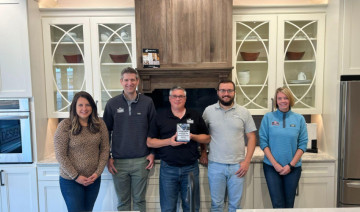{article.name}
Social Media Links
American Residential Design Awards (ARDA)

- Share this:
- Share on Facebook
- Pin on Pinterest
- Tweet on Twitter
American Residential Design Awards (ARDA)
Offered by the American Institute of Building Design, formerly known as the AIBD Design Competition, the ARDA 2022 program is no different than years past, with a 14 year high of 168 entries from 63 designers including AIBD members and non-members. This also gave ARDA a record of 110 awards to be presented. Submissions range from all types of design, from remodeling to custom homes. In this program all entries are judged on their own merits. The judges are selected each year from the design and construction fields. This gives every entry the same chance to receive an award. 41 Lumber is the first firm from the Upper Peninsula, Michigan & Wisconsin area to win an ARDA award ever.

Award Details
● GRAND ARDA WINNER for Brown Street
Victorian (Category: Renovation - Unbuilt)
● Designed by - Team 41 Lumber (Michael Roman
CPBD, Michael Miller, Ben DeRidder & Stephanie Sotka)
● Homeowner - Carol Quandt (COO 41 Lumber)
● Property (located in Iron Mountain) showcased below:

Renovation of a 150 year old Victorian Home. There are 2 additions that were built onto the home that did not fit the style of the home. These will be removed and re-built. A small existing front porch will also be removed to allow for a larger wrap around porch. The existing kitchen is removed and will become a sunroom. The existing dining room becomes a family room. The existing den becomes the new kitchen and a portion of the living room will be used as a dinette. Upstairs combines 2 small bedrooms and closet spaces to become a new Master Suite that takes advantage of the new 2nd floor deck and the beautiful view as well as gathering the morning sun for the homeowner.
Interview with Michael Roman
Background: Victorian Homes
As soon as Carol told me about this project, my eyes lit up right away because Victorians are my style - from back when I was a builder. That’s what kept me in the project because it was right up my alley. When I was building back in the day, we did a lot of restoration work with historical societies. And that’s one of the things that was so neat, to be able to see homes built in the late 1800s, pictures and research of what they used to look like. In order to get grants from the historical societies you’d have to completely restore it to how it was built originally. For example, looking at old pictures and seeing that all these windows weren’t there, so you’d have to pull them out. Or noticing that there was a window that’s now been covered up which was then part of restoring a historically accurate window.
This Project vs. restoring traditional Victorian homes
With respect to the Victoria Brown project, it is a fusion of keeping the essence of the old Victorian home but adding in the modern/contemporary to it. The contemporary elements were driven primarily by Carol, the homeowner, who wanted specific elements to be incorporated in the house and we did our best to bring out those features. For example, she wanted a front porch just a little bigger than what was already there but wrap-arounds were more fitting for Victorians, so after 3-4 versions, we changed it from a small front porch to a wrap-around.
The only thing the homeowner was hesitant about when I first presented to her was the upstairs master bedroom suite. Every time we did a walkthrough of the house, there was one bedroom that was her absolute favorite because of the view of the morning sun through the windows. So we combined two bedrooms upstairs to create the master suite.
Technical details for the house came from Field Guide to American Homes, which breaks down every type of home (Victorian, Colonial) and all the genres and subgenres of these homes, some of it was from experience, some were from pictures that Carol had liked and a lot of it was already on the structure - brackets, pediments on the roof, etc. It was a matter of making a decision, and that’s where our 3D tool at the Design Center came in, which allowed us to see how the home would look like with/ without these features. I am glad that we decided to keep them.
Pros & Cons during build
Happy discoveries always happen when working on old homes like this. As you start opening walls up, one often finds little calling cards from builders who’ve worked on it before. Or sometimes you’ll remove the flooring, you’ll find chunks of hardwood flooring with names/initials of carpenters who worked on it – back in the day people were really proud of their work and art. The biggest challenge for me would be getting the hardwood floor refinished back into what it used to be; there are lots of elements that need to be taken into account to flatten it out and save the floor.

From left to right (Team 41 Lumber): Stephanie Sotka (Kitchen & Bath Designer), Michael Miller (Senior
Residential Designer), Michael Roman (Lead Residential Designer, CPBD), Ben DeRidder (Residential
Designer), Carol Quandt (Chief Operations Officer)
Sign up for our Email List
Stay updated with all our latest posts, products and offers! Just enter your information below.


Comments